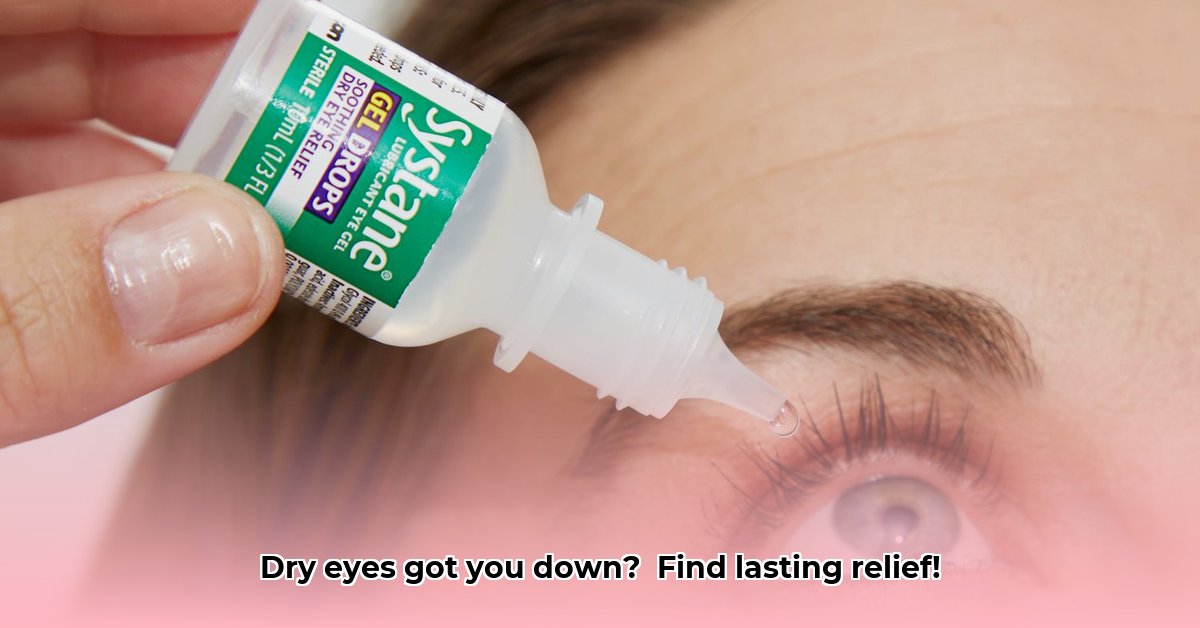Dry, itchy, burning eyes making life miserable? You’re not alone. Many struggle with dry eyes – a common problem where your eyes don’t produce enough tears, or the tears aren’t of the right quality. For additional skincare options, check out this helpful resource on skincare products. This guide walks you through using eye gels for relief, explaining the causes of dry eyes, how eye gels work, helping you choose the best one, proper usage, and suggesting impactful lifestyle changes for improved comfort. Let’s alleviate those tired eyes!
Eye Gel for Dry Eyes: Your Guide to Lasting Relief
Dry eyes – that gritty, scratchy feeling – can significantly impact your daily life. It’s more than just occasional dryness; it’s a condition where your eyes don’t produce sufficient tears, or your tears evaporate too rapidly, leaving your eyes feeling irritated. Let’s explore finding the right eye gel and lifestyle adjustments for lasting relief from discomfort and preventing potential corneal damage.
Understanding Dry Eye Syndrome: What’s Really Happening with Your Tear Film?
Dry eye syndrome is a widespread issue affecting millions, where eyes either don’t produce enough tears or the tears evaporate prematurely. Think of tears as the perfect lubricant, maintaining comfort and clarity. Insufficient lubrication leads to that uncomfortable dryness, irritation, burning, and blurry vision. Causes range from aging and medications (like antihistamines, decongestants, blood pressure pills, or antidepressants) to environmental factors (dry air, wind, smoke), prolonged screen time, contact lens use, and underlying medical conditions such as Sjogren’s syndrome, rheumatoid arthritis, or thyroid disorders, which affect moisture production in the body. Even hormonal changes, particularly in women during menopause, can contribute to dry eyes.
How Eye Gels Work: Replenishing Your Natural Moisture Barrier
Eyes are naturally coated with a three-layered tear film: an oily (lipid) outer layer, a watery (aqueous) middle layer, and a mucus (mucin) inner layer. This tear film is crucial for keeping your eyes moist, healthy, and clear. The oily layer prevents evaporation, the watery layer provides hydration and washes away debris, and the mucus layer helps the tears spread evenly. Eye gels supplement this tear film, providing extra moisture and prolonged lubrication. Unlike regular eye drops, eye gels have a thicker consistency, allowing them to remain longer on the eye surface. This, in turn, provides lasting relief from discomfort. Some gels also contain ingredients that help to restore the natural balance of your tear film.
Navigating the World of Eye Gels: Preserved vs. Preservative-Free Options
Two primary types of eye gels exist: those with preservatives and those without. Preserved gels are typically more affordable and come in multi-dose bottles for convenience. Common preservatives include benzalkonium chloride (BAK) and Polyquad. However, preservatives may irritate sensitive eyes or cause allergic reactions with prolonged use. Preservative-free gels, usually in single-use vials, are gentler, avoiding these potential irritants. They often contain ingredients like sodium hyaluronate for enhanced hydration. The downside is a higher cost and shorter shelf life once the vial is opened. The ideal choice depends on individual needs and sensitivity. Some tolerate preserved gels, while others require the gentleness of preservative-free formulas, especially if using eye gels multiple times a day.
Finding the Right Eye Gel for You: Making an Informed Decision
Choosing the perfect eye gel comes down to personal preference and specific needs. Consider these factors:
-
Symptom Severity: For mild dryness, an over-the-counter (OTC) eye gel might suffice. These often focus on simple lubrication. Consult your eye doctor for moderate or severe symptoms, persistent discomfort, or vision impairment. They can diagnose and recommend specific treatments, including prescription options like Restasis or Xiidra (which address inflammation), and address underlying causes. Did you know that approximately 50% of adults experience dry eye symptoms at some point in their lives, and the prevalence increases with age?
-
Lifestyle: Do you spend extended hours in front of screens? Live in a dry climate? Frequent airplane travel or air-conditioned environments? These conditions exacerbate dry eye. If yes, you’ll likely need a gel offering prolonged relief and consider using it preventatively. Look for gels with ingredients that mimic the natural tear film components.
-
Contact Lens Use: Certain eye gels aren’t compatible with contact lenses and can interfere or even damage them. They may cause clouding or discomfort. Ensure your chosen gel is specifically labeled as suitable for contact lens wearers. Some are designed to rewet lenses and provide comfort. Always follow the label instructions carefully. Remove lenses if irritation occurs.
-
Specific Needs: Consider gels formulated for nighttime use if your dry eyes are worse when you wake up. These are typically thicker and provide longer-lasting lubrication while you sleep. If you have meibomian gland dysfunction (MGD), look for gels containing lipids or omega-3 fatty acids to support the oily layer of the tear film.
A quick note: Consult your eye doctor or pharmacist before using any new product, especially if you have existing eye conditions, allergies, or are using other eye medications.
Using Eye Gel Properly: A Step-by-Step Application Guide
Proper application is key to maximizing eye gel benefits and avoiding potential issues. Follow these steps:
- Wash Your Hands: Start with clean hands to prevent bacteria from entering your eyes.
- Read the Label: Always read and follow the specific instructions provided with your chosen eye gel.
- Tilt Your Head Back: This helps the gel reach your eye’s surface. Alternatively, lie down.
- Gently Pull Down Your Lower Eyelid: Create a small pocket between your lower eyelid and eyeball.
- Apply a Small Amount of Gel: Squeeze a tiny amount of gel into the pocket. Excessive gel can cause blurry vision. Start with a small drop and adjust as needed.
- Close Your Eyes Gently: Close your eyes gently for 1-2 minutes to allow the gel to spread across the eye’s surface. Avoid squeezing your eyes shut, as this can force the gel out.
-
Wipe Away Excess: If necessary, gently wipe away any excess gel around your eyes with a clean tissue.
Important: Never touch the eye gel container tip to your eye or any other surface to prevent contamination. If using single-use vials, discard the vial after each use, even if there is gel remaining.
Lifestyle Adjustments: Supporting Your Eyes Holistically
Eye gels provide relief, but lifestyle changes greatly enhance their effectiveness and offer additional benefits. Incorporate these habits:
- Hydration: Drink plenty of water daily (8-10 glasses) to support overall health, including tear production. Dehydration worsens dry eye symptoms.
- Omega-3 Fatty Acids: Include omega-3 fatty acids in your diet through foods like fish, flaxseeds, and walnuts, or consider taking a supplement. Omega-3s can help improve tear quality.
- Screen Time Management: Prolonged screen time dries eyes significantly because we blink less frequently. Implement the 20-20-20 rule: Every 20 minutes, look at an object 20 feet away for 20 seconds. Consciously blink more often while using screens.
- Humidify Your Environment: Humidifiers add moisture to the air, preventing rapid tear evaporation, especially in dry seasons or climates. Aim for a humidity level between 30-50%.
- Environmental Protection: Shield your eyes from wind, intense sun, and smoke, all contributing to dryness. Wear wraparound sunglasses outdoors, even on cloudy days.
- Eyelid Hygiene: Practice good eyelid hygiene to prevent blepharitis (inflammation of the eyelids), which can worsen dry eye. Use a warm compress on your eyelids for 5-10 minutes daily, followed by gentle eyelid massage and cleaning with a mild cleanser like diluted baby shampoo.
When to Seek Professional Help: Recognizing When Over-the-Counter Isn’t Enough
While OTC eye gels work well for mild to moderate dry eye, it’s crucial to know when to seek professional help. See your eye doctor if:
- Symptoms worsen or persist despite using OTC eye gels for more than a week.
- You experience severe discomfort, pain, or significant vision changes.
- You notice changes in your eye’s appearance, such as excessive redness or discharge.
- You suspect an infection.
- Dry eye is interfering with your daily activities.
Your eye doctor can identify underlying causes, perform a comprehensive eye exam, and recommend tailored treatments. They may perform tests to assess tear production and quality, rule out other eye conditions, and prescribe medications or procedures if necessary.
Frequently Asked Questions (FAQs) About Eye Gel
- Allergies: Test for allergic reactions by applying a tiny amount of eye gel to the skin around your eye. Discontinue use and consult a doctor if you experience irritation (redness, itching, swelling).
- Can I use eye gel long-term?: Consult your eye doctor about long-term application. They can assess the gel’s suitability, monitor for any side effects, and adjust your treatment plan if needed.
- Will eye gel interact with other medications?: Inform your doctor or pharmacist about all current medications and supplements before using a new eye gel to ensure no potential interactions.
- Can I use eye gel with makeup?: It’s best to apply eye gel before applying makeup to avoid contamination. Remove makeup thoroughly
- Male Eating Disorders Often Missed but Increasingly Prevalent - October 29, 2025
- Males With Anorexia Nervosa Have Distinct Symptoms and Treatment Needs - October 28, 2025
- Weight Loss for Men Builds Habits for Lasting Success - October 27, 2025










